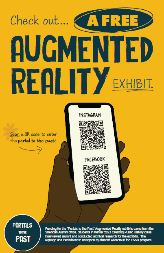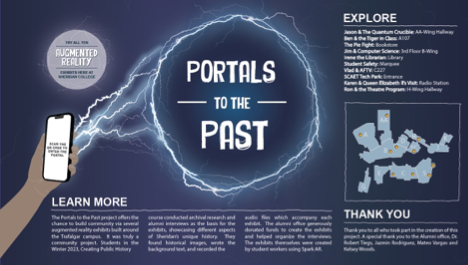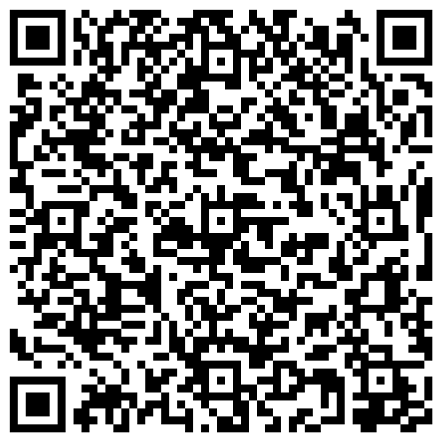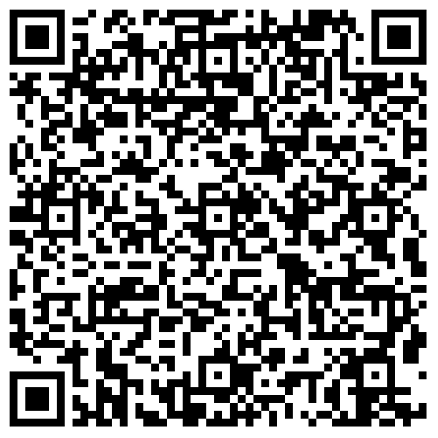Portals to the Past: Augmented Reality Exhibits Showcasing Sheridan’s Rich History
“Interesting things happen here” – Bob Tiegs
Is it a faux-pas to quote yourself at the start of your own essay? It doesn’t matter, I’ve already typed it. In any case, those were the words that I repeated almost ad-nauseam to all the people who were part of my most recent Public History project. The project involved the creation of augmented reality exhibits around the Trafalgar campus which depicted the important, the wild, and the memorable parts of Sheridan’s unique history. At heart, the quote is both a declaration and a call to action. It is both an affirmation that exciting things happened at Sheridan and that you should go search them out.

It’s probably best to start at the beginning and explain the idea behind it and the goals, then jump to end to discuss the finalized exhibits, then pivot to the middle in order to walk through the challenges involved. At the beginning, this project was largely conceived during the pandemic. At this point most of us were sitting at home, struggling through lockdowns, the online learning, and feeling removed from Sheridan. It was during this time that I thought it would be nice to have something to welcome back students, faculty, employees, and visitors to our college when it reopened. In short, the goal was to help build (or rebuild) community on campus by showcasing its history.
Now to jump to the end, three student workers from the FAAD program were able to create ten augmented reality exhibits across the Trafalgar campus based on student research in my Winter 2023 Public History course. In the class groups of students researched and curated the content for the exhibits. We were fortunate to be able to follow-up on a lot of material that my colleagues had put together for the Sheridan @ 50 celebration. Following in these footsteps, the students conducted research in past volumes of the Sheridan Sun and also interviewed alumni and retired employees. Then the FAAD students spent the Spring and Summer semesters actually creating the exhibits. There are posters at each exhibit where users can scan the QR codes and access the exhibits either via Facebook or Instagram apps (see left). Each exhibit includes a historic photograph and an audio description for context.
We created two exhibits on Queen Elizabeth II’s visit in 2002. One focused on the visit itself, discussing the stately dinner we hosted and how they made a special bathroom just for her majesty. The other focused on our gift to the queen, a lavish glass bowl created by one of our professors. There were four exhibits describing the accomplishments of former faculty and employees. One was on a current librarian who actually earned her degree here. Two others looked at faculty contributions to their respective programs: Film and Theatre. The last one from this category centered on the old IBM computers that took up entire rooms. The other exhibits were a bit more of a hodgepodge. One exhibit looked at a pie fight that broke out in the halls. Another one looked at Sheridan’s efforts to keep students safe. One depicted the construction of SCAET and the proposed technology park. The last one discusses the time a live tiger was brought into an animation class and gave one of the students a lick. There is a large display outside of the FHASS office at Trafalgar that describes the project which also includes a map of where you can find the exhibits (see below).

As for the middle, and how this project came together, I saved that for last since it might not be of interest to everyone. It speaks to classroom activities, searching for funding, and government approval. It’s not for the feint of heart. I include it though so that others who are doing research or conducting their own projects can commiserate and learn from my experiences.
Getting everything ready for the students in the Public History course was a mixed bag. I first pitched the idea to my AD, and she was very supportive. I applied for a SRCA grant, but did not get it. So, we pivoted and got funding from the alumni office as long as the project included alumni interviews, which I was happy to oblige. Conducting interviews, though, requires REB approval. So, obliviously I decided to procrastinate rather than getting started on that. Actually, my focus shifted toward trying to find the best Augmented Reality software and technicians who could do the work. Since Sheridan pays for the Adobe Suite I decided that Adobe Aero would be a good choice. After asking around at Sheridan, I got in touch with the Adobe representative, who recommended a faculty member who could help. Yes. I had to go outside the college to find a contact within the college. In any case, he was a wonderful resource. He helped me find a free program, Spark AR by Meta, and played a key role in locating incredible student workers. With that figured out, I started my REB application a semester early, in Fall 2022.
During the Public History course, things went well but there were still moments of trepidation. We started by having students think about what makes Sheridan memorable for them. What types of activities, events, and classes do they think they will remember after they leave. These became the themes we wanted to explore as we started our research. The library staff were incredibly helpful locating, organizing, and setting aside time for students to conduct their research. I earned my REB approval just a few weeks before the alumni interview took place, and there was a lot of anxiety around locating potential interviewees. In the end, it came together really well, but like all projects, it could have gone more smoothly.
Click on the circular blue button with headsets to hear the audio:
Facebook QR Code to the Pie Fight:

Facebook QR Code to the SCAET:


